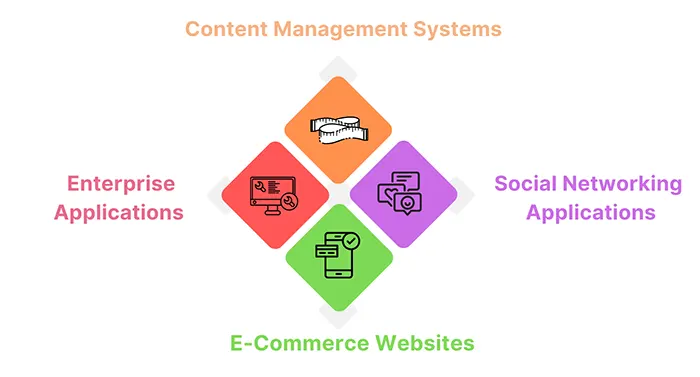
Posted on Wednesday, Jul 26th, 2023
CodeIgniter: Where Innovation Meets Web
Spread the love
CodeIgniter, a powerful and flexible PHP framework, has been a driving force behind countless successful web development projects. With its ability to combine simplicity, speed, and versatility, CodeIgniter has proven itself as a framework where innovation truly meets the web.
The Essence of CodeIgniter
CodeIgniter framework also follows the MVC (Model-View-Controller) architectural pattern. It is designed to offer developers a straightforward and elegant platform to build web applications rapidly. Its minimalistic approach, combined with a small footprint, ensures faster performance and easy scalability.Innovative Features
a. Lightweight and Fast
CodeIgniter's lightweight core ensures quick response times, making it an ideal choice for high-performance applications. It’s efficient routing and caching mechanisms further contribute to its speed and performance.b. Flexible Configuration
It embraces the philosophy of "convention over configuration" while allowing developers to customize their projects based on specific needs. Its flexible configuration system empowers developers to tweak the framework to suit their project requirements easily.c. Form Validation and Security
Security is paramount in web development, and CodeIgniter framework comes equipped with built-in form validation and security features to protect against common vulnerabilities like SQL injection and XSS attacks.d. Error Handling and Logging
The comprehensive error handling and logging capabilities simplify the debugging process, ensuring a smooth development experience.e. Great Documentation
CodeIgniter has extensive and well-organized documentation, making it easy for developers to find the information they need and understand the framework's features and functions better.f. RESTful API Support
The CodeIgniter framework's built-in support for RESTful APIs makes it a go-to choice for building web services and APIs, allowing seamless integration with various platforms.CodeIgniter and Innovation
a. Rapid Development
It has a user-friendly interface and simple syntax enable developers to write code quickly and efficiently. This encourages innovation by reducing the development time, allowing more time for creativity and experimentation.b. Versatility
CodeIgniter framework uses modular structure that enables developers to use libraries, helpers, and plugins to extend the framework's functionality. This versatility opens up endless possibilities for innovation by allowing developers to incorporate cutting-edge features effortlessly.c. Community and Documentation
It boasts a vibrant and active community that fosters a culture of knowledge-sharing and innovation. The vast collection of resources, tutorials, and documentation makes it easy for developers to learn, experiment, and innovate.d. Integration with Frontend Technologies
It seamlessly integrates with popular frontend technologies like HTML, CSS, and JavaScript frameworks, empowering developers to build modern and innovative user interfaces.Real-Life Use Cases

a. E-Commerce Websites
It's speed and versatility makes it an excellent choice for developing feature-rich e-commerce websites with advanced product catalogs, user authentication, and payment gateways.b. Content Management Systems (CMS)
With this, developers can create robust and user-friendly CMS platforms that allow content creators to manage and publish content effortlessly.c. Social Networking Applications
Moreover, the RESTful API support makes it an excellent option for developing social networking applications that require smooth interaction between multiple platforms.d. Enterprise Applications
CodeIgniter's scalability and security features make it a favored framework for building complex enterprise-level applications with stringent security requirements.CodeIgniter Framework Development
Want to start CodeIgniter Framework Development, here's a step-by-step guide to help you get started:Step 1: Installation
• Download the latest version of CodeIgniter from the official website (https://codeigniter.com/).• Extract the downloaded ZIP file to your local development environment.
• Place the extracted CodeIgniter files in your web server's document root or any directory accessible via the web.
Step 2: Configuration
• Navigate to the application/config directory.• Open the config.php file and set the base URL and other configuration settings specific to your environment.
Step 3: Create Controllers
• In the application/controllers directory, create a new PHP file for each of your controllers.• Controllers handle user requests, interact with models, and load views to display data.
Step 4: Create Models
• In the application/models directory, create a new PHP file for each of your models.• Models interact with your database, handle data retrieval, and business logic.
Step 5: Create Views
• In the application/views directory, create folders to organize your views.• Within these folders, create PHP files to represent the views for each controller.
Step 6: Routing
• Define custom routes in the application/config/routes.php file to map URLs to your controllers and methods.• By default, CodeIgniter follows the controller/method URI pattern.
Step 7: URL Structure
• CodeIgniter uses query strings by default, but you can configure it to use "search-engine-friendly" URLs by enabling URL rewriting.Step 8: Controller Actions
• Define methods within your controllers to handle different actions, such as displaying data, processing forms, etc.• Load views and models within your controller methods as needed.
Step 9: Working with Models
• Inside your models, use CodeIgniter's database class to perform CRUD (Create, Read, Update, Delete) operations.• Model functions should encapsulate database interactions.
Step 10: Views and Templates
• Design your HTML templates and layout using the views.• Use PHP and CodeIgniter's built-in template engine to display dynamic data.
Step 11: Validation
• Utilize CodeIgniter's form validation library to validate user input and ensure data integrity.Step 12: Error Handling and Logging
• Implement error handling and logging to catch and log errors for debugging and troubleshooting purposes.Step 13: Security
• Follow security best practices, such as form validation, input sanitization, and output escaping, to prevent common web vulnerabilities.Step 14: Testing
• Write test cases using PHPUnit or other testing libraries to ensure your application functions as expected.Step 15: Deployment
• Upload your CodeIgniter application to a web server that meets the system requirements of the framework.• Make sure to configure your server correctly for production use.
Remember that this is a basic guide to get started with CodeIgniter development. As you progress, you can explore more advanced features, libraries, and third-party extensions to enhance your development experience.
Advantages of CodeIgniter
CodeIgniter stands out among other PHP frameworks due to its unique set of advantages. While different frameworks have their strengths, CodeIgniter's features offer distinct benefits that make it a preferred choice for many developers. Here are some advantages of CodeIgniter over other frameworks:1. Simplicity and Ease of Learning
CodeIgniter's simplicity and straightforward syntax make it easy for developers, including beginners, to get started quickly. Its small learning curve allows developers to grasp the fundamentals of the framework rapidly, making it an accessible option for newcomers to PHP development.2. Lightweight and High Performance
It is renowned for its lightweight nature and small footprint. Its minimal impact on server resources translates to faster response times and improved performance. This advantage is particularly beneficial for applications with high traffic or limited server resources.3. Flexible and Customizable
It's flexibility allows developers to tailor the framework to their specific project requirements. Developers can select and integrate only the necessary libraries, helpers, and components, resulting in leaner and more efficient applications.4. Efficient Documentation
It boasts extensive and well-organized documentation. This comprehensive resource makes it easy for developers to find information, understand the framework's functionality, and quickly address any development challenges they encounter.5. Active Community and Support
It has a vibrant and active community of developers. This means a wealth of online forums, tutorials, and resources where developers can seek assistance, share knowledge, and collaborate. The community's support ensures that CodeIgniter remains up-to-date and relevant.6. Low Barrier to Entry
Unlike some other frameworks that require a deeper understanding of advanced concepts, CodeIgniter's simplicity allows developers to start building applications with minimal barriers to entry. This advantage makes CodeIgniter an attractive option for small to medium-sized projects or when time is of the essence.7. MVC Architecture
CodeIgniter adheres to the Model-View-Controller (MVC) architectural pattern. The separation of concerns offered by this pattern simplifies code maintenance, improves organization, and enhances overall development efficiency.8. Built-in Security Features
CodeIgniter comes with built-in security features, such as form validation, XSS (Cross-Site Scripting) filtering, and CSRF (Cross-Site Request Forgery) protection. These features help developers implement secure applications and mitigate common web vulnerabilities.9. Excellent Database Support
CodeIgniter provides a robust database abstraction layer, supporting various databases. Developers can easily switch between different database systems without significant code changes, allowing for smooth integration with different projects.10. Legacy Application Support
CodeIgniter's long-standing presence in the PHP community means there are numerous legacy projects built on this framework. For developers maintaining or upgrading existing applications, CodeIgniter offers a stable and reliable choice.Conclusion
CodeIgniter's remarkable blend of simplicity, speed, and flexibility has made it a hotbed of innovation in the world of web development. Its ability to empower developers with the tools they need to create efficient web applications has established it as a force to be reckoned with in the industry.Whether it's rapid prototyping, building large-scale web applications, or creating modern web services, CodeIgniter continues to be a go-to choice for developers seeking innovation and excellence. With an active community, comprehensive documentation, and an ever-evolving ecosystem, it promises to remain at the forefront of web development innovation for years to come.
For businesses seeking a highly-efficient, professional, and customized application tailored to their unique needs, Blue Summit extends a warm invitation to get in touch with us today. Our team of skilled experts is committed to delivering top-notch solutions that perfectly align with your vision and objectives. So, let's embark on a journey with CodeIgniter together, where innovation truly meets the web.
Blue Summit has collaborated with OdiTek Solutions, a frontline custom software development company. It is trusted for its high service quality and delivery consistency. Visit our partner's page to720day and get your business streamlined.
REFER TO OTHER RELEVANT CONTENTS

CodeIgniter Framework
The PHP CodeIgniter framework is a powerful framework for creating dynamic applications that are fully functional. CodeIgniter development lets you separate data from visual presentation and application logic because it is based on the MVC pattern. Using PHP CodeIgniter development, you can construct robust and...
read more







